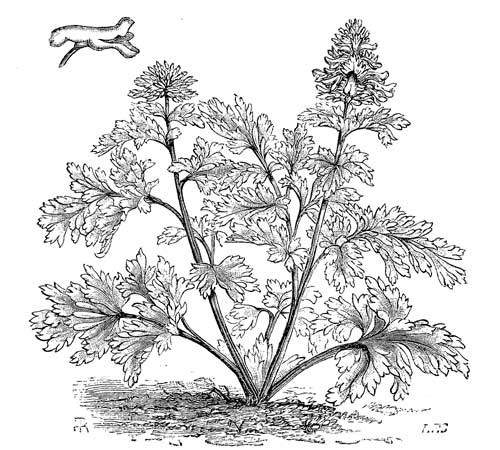Corydalis Nobilis
Noble or Great-flowered Corydalis; Nat. Ord. Fumariace?

Fig. 29. Corydalis Nobilis.
(One-half natural size; blossom, natural size.)
A hardy tuberose perennial, imported from Siberia in 1783. It is one of that section of the Fumitories called "Hollowe Roote," the appropriateness of which name is most amply illustrated in the species now under consideration. If, in the first or second month of the year, a strong specimen is examined, the long and otherwise stout tuberous root will be found, immediately under the healthy and plump crown, to be not only hollow, but so decayed that the lower and heavy fleshy parts of the root, which are attached to the crown by a narrow and very thin portion of the root bark, in such a way as to suggest that the lower parts might as well be cut off as useless—but, let me say, do not cut it. If it is intended to replant the specimen, let it go back to "Mother Earth" with all its parts, deformed as some may seem to us; otherwise Corydalis nobilis will be anything but a noble plant at the flowering season; it may not die, but it will probably make for itself another "hollowe roote" before it produces any flowers, The habit and form of this plant are perfect (see Fig. 29), and there are other points of excellence about it which cannot be shown by an engraving, in the way of the arrangements of colours and shades. Seldom does the little plant, so full of character, exceed a height of 8in. The specimen from which the drawing was made was 7in., and grown fully exposed in a pot plunged in sand. Another plant, grown on rockwork, "high and dry," is about the same size, but it looks better fed. Probably the long roots are short of depth in pots, and the amount of decay may soon poison the handful of mould contained therein. Be that as it may, the specimens grown in pots have a hungry appearance compared with those less confined at the roots.
The flowers are a pleasing mixture of white, yellow, brown, and green. The four petals are of such a shape and so arranged as to form a small snapdragon-like flower. These are densely produced in a terminal cluster in pyramid form on the stout and richly-foliaged stem; dense as is the head of flowers, every floret is alternated with a richly-cut leaf, both diminishing in size as they near the top. The older flowers become yellow, with two petals tipped with brown, the younger ones have more white and green, and the youngest are a rich blend of white and green; the head or truss is therefore very beautiful in both form and colour, and withal exquisitely scented, like peach blossom and lilac. The leaves are stalked bipinnate; leaflets three-parted, cut, and glaucous; there are few plants with more handsome foliage, and its beauty is further enhanced by the gracefully bending habit of the whole compound leaf. The flowers are too stiff for cutting, and otherwise their fine forms, colours, and perfume cannot well be enjoyed unless the plants are grown either in pots or at suitable elevations on rockwork, the latter being the more preferable way. The long blooming period of this plant adds not a little to its value, lasting, as it does, quite a month, the weather having little or no effect on the flowers.
Any kind of sweet garden soil seems to do for it, and its propagation is carried out by careful root division.
Flowering period, April to June.
Данный текст является ознакомительным фрагментом.